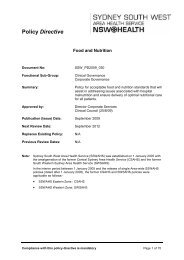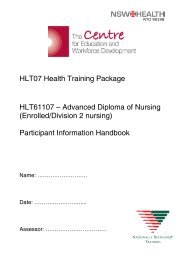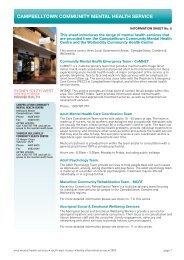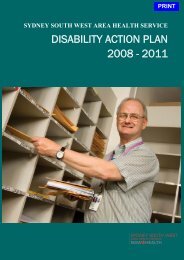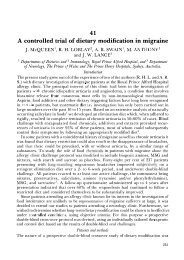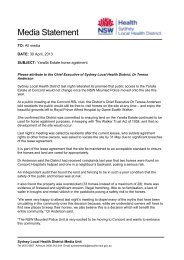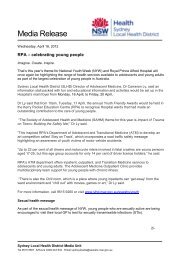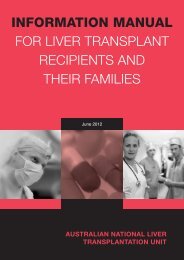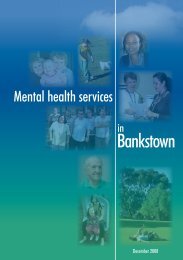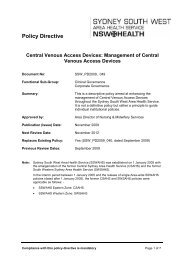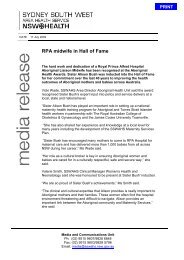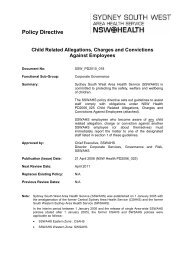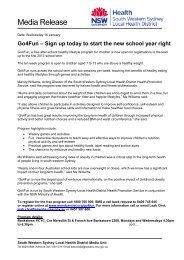Aged Care & Rehabilitation Clinical Services Plan 2007 – 2012
Aged Care & Rehabilitation Clinical Services Plan 2007 – 2012
Aged Care & Rehabilitation Clinical Services Plan 2007 – 2012
You also want an ePaper? Increase the reach of your titles
YUMPU automatically turns print PDFs into web optimized ePapers that Google loves.
<strong>Aged</strong> <strong>Care</strong> & <strong>Rehabilitation</strong> <strong>Clinical</strong> Service <strong>Plan</strong> <strong>2007</strong> - <strong>2012</strong>• Patients with severe aggression – a number of patients in hospital display severe behaviouraldisturbance and aggression. They require specialised care and support, to improve safety forthe patient themselves, other patients and staff. This group of patients are at significant risk ofcreating adverse events and are resource intensive with a high rate of one to one nursing; and• Data and performance management – Data on inpatient activity is variable, due to a range offactors including the inability to sort patients by particular AN-DRGs, the presence of sharedwards and shared specialties, and current data collection issues.Projected Future ActivityProjected future activity and need for additional inpatient beds calculated is based on estimatedactivity in 2004/05 and a clinically validated benchmark of likely future activity. This benchmarksuggests that in the future 0.05% of people aged over 65 years will require an acute aged care bedand have a 12 day ALOS, and 0.03% of people aged over 65 years will require a sub-acute agedcare or rehabilitation bed, with a 20 day ALOS. This includes consideration of increased beddaysassociated with falls and the projected number of patients with dementia/delirium (refer Sections4.1.1, 4.1.2 and 4.1.3).Table 6.12 following indicates that by 2016 there will be over 16,000 separations annually, utilisingalmost 250,000 beddays. If there are no changes to the models of care for AC&RS clients by 2016,over 300 additional beds would be required.Table 6.12 Projected Acute & Sub-Acute <strong>Aged</strong> <strong>Care</strong> & <strong>Rehabilitation</strong> ActivitySouth West2006 2011 (estimated) 2016 (estimated)<strong>Services</strong> Pop Beds Pop Seps Beddays Pop Seps Beddays<strong>Aged</strong> <strong>Care</strong>* 5,099 61,188 6,190 74,274<strong>Rehabilitation</strong> 87,790 204 101,980 3,393 67,863 123,790 4,119 82,376Total AC&RS8,492 129,05110,308 156,6502006 2011 (estimated) 2016 (estimated)Eastern <strong>Services</strong> Pop Beds Pop Seps Beddays Pop Seps BeddaysAcute AC 3,283 39,402 3,679 44,149Sub Acute 1,494 29,888 1,674 33,48961,295 230 65,19673,051<strong>Rehabilitation</strong> 613 12,253 686 13,729Total AC&RS5,391 81,5436,040 91,368Source: Cerner 2004/05 and DIPNR Population Projections 2004Assumptions and Notes:1. The EZ runs a specific sub-acute geriatric service. Equivalent patients in the WZ are treated in rehabilitation beds.2. Where general medicine is provided by geriatricians, it has not been possible to separate the activity. Adjustments of projectedbed numbers downwards are required to reflect this activity (captured in planning for EZ through the RTP, and WZ through theMedicine and Ambulatory <strong>Care</strong> <strong>Plan</strong>). General Medicine activity has not been projected for any hospital with a unique generalmedicine service.3. <strong>Aged</strong> <strong>Care</strong> activity in the WZ includes aged care psychiatry beds which are planned for in the Mental Health <strong>Clinical</strong> <strong>Services</strong><strong>Plan</strong>. Projected bed numbers will need to be adjusted downwards to reflect this activity.4. <strong>Rehabilitation</strong> in the WZ includes the stroke unit at Bankstown - also addressed in medicine plan under neurology and thereforeprojected bed numbers may need to be adjusted downwards to reflect this activity.5. Not all rehabilitation clients are aged 65+, though the focus of the service is on older people.It is recognized that it will not be possible to provide the infrastructure required, based on theprojections referred to in Table 6.12, although some beds may be provided through a reconfiguredbed base. However, it is evident that a significant increase in inpatient beds will be required to meetadditional demand over the next 10 years. To counter this demand for AC&RS inpatient beds, arange of supplementary support services, and improved management of all older people within thehospital environment, must be provided. These were discussed throughout Sections 6.1 and 8.Through planning for the Liverpool Hospital Stage 2 redevelopment, it has been agreed to developan additional AC&RS capacity of 30 beds (taking the total bed numbers to 50, in two 25 bed units).Eight of these beds have been dedicated to rehabilitation. The AC&RS units will be complementedby an additional 20 bed aged care psychiatry unit within the proposed AC&RS precinct. It isenvisaged at this stage that these beds will be operational by 2016.Page 53




